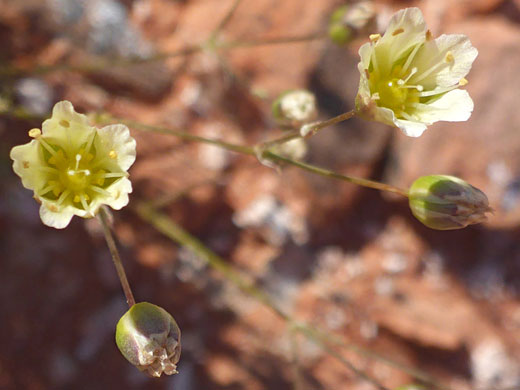Common names:
Mojave sandwort, desert sandwort
Family:
Scientific name:
Eremogone macradenia
Main flower color:
Range:
The Mojave Desert, and some adjacent areas
Height:
Usually up to 16 inches
Habitat:
Desert slopes and flats, open woodland, sagebrush, from 2,000 to 7,200 feet
Leaves:
Opposite, cauline, narrow, linear, up to 2 inches long
Season:
April to June
The range of eremogone macradenia extends from the foothills of the mountains north of Los Angeles, across the Mojave Desert, to parts of the Great Basin Desert in Utah. Stems (and pedicels) are usually hairless but may have a sparse covering of stalked, glandular hairs. Leaves are cauline, not basal; five to 12 opposite pairs, concentrated at the lower portion of the stem. Leaves are narrow, linear, pointed, resembling pine needles.
The inflorescence is an open cluster, of between three and 20 flowers, the branches angled upwards. Pedicels are up to 1.5 inches in length. The five sepals are elliptic to broadly lanceolate, hairless to sparsely glandular, with thin, light-colored margins. Petals are pale yellow to white, up to twice as long as the sepals, slightly wavy along their upper edge. Stamens are about as long as the petals.
There are two varieties of eremogone macradenia; var macradenia has up to eight pairs of leaves, pointing upwards, while the less common (California only) var arcuifolia has up to 12 pairs of leaves, often curved downwards, and slightly wider.
The inflorescence is an open cluster, of between three and 20 flowers, the branches angled upwards. Pedicels are up to 1.5 inches in length. The five sepals are elliptic to broadly lanceolate, hairless to sparsely glandular, with thin, light-colored margins. Petals are pale yellow to white, up to twice as long as the sepals, slightly wavy along their upper edge. Stamens are about as long as the petals.
There are two varieties of eremogone macradenia; var macradenia has up to eight pairs of leaves, pointing upwards, while the less common (California only) var arcuifolia has up to 12 pairs of leaves, often curved downwards, and slightly wider.
All Contents © Copyright The American Southwest | Comments and Questions | Contribute | Site Map



